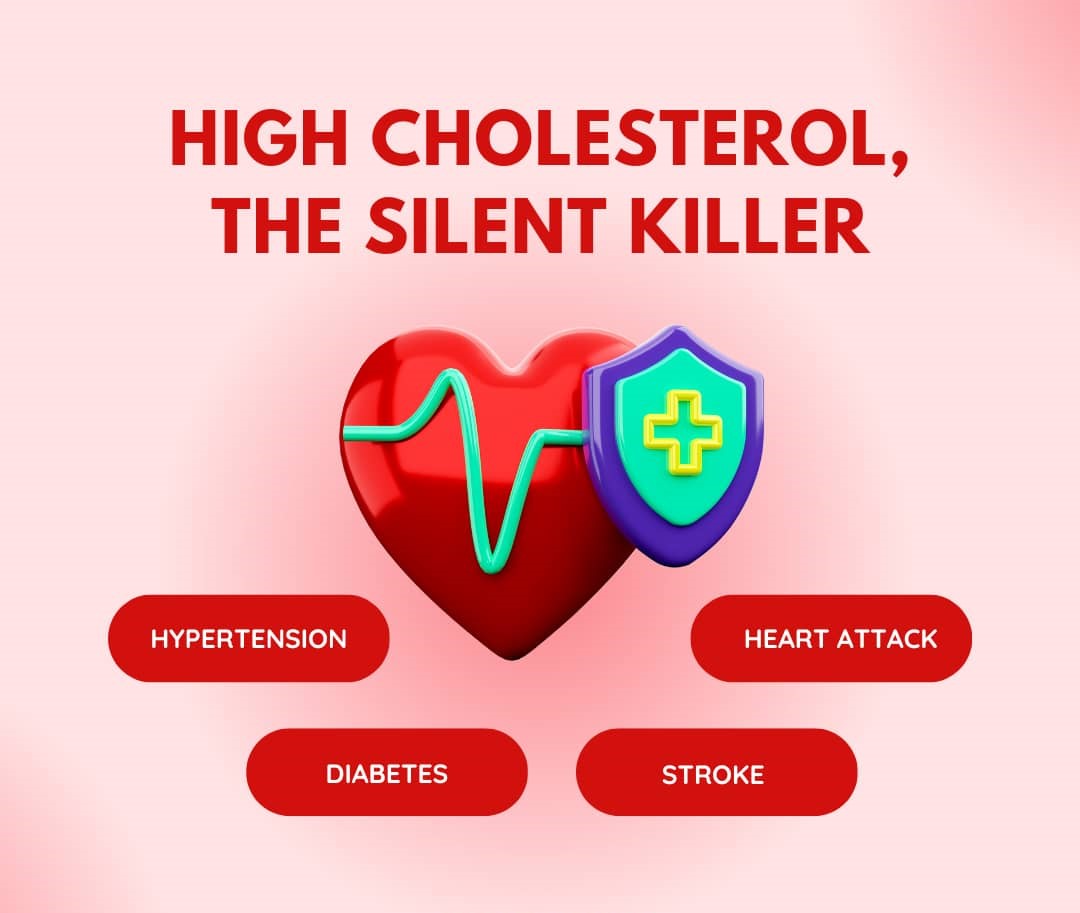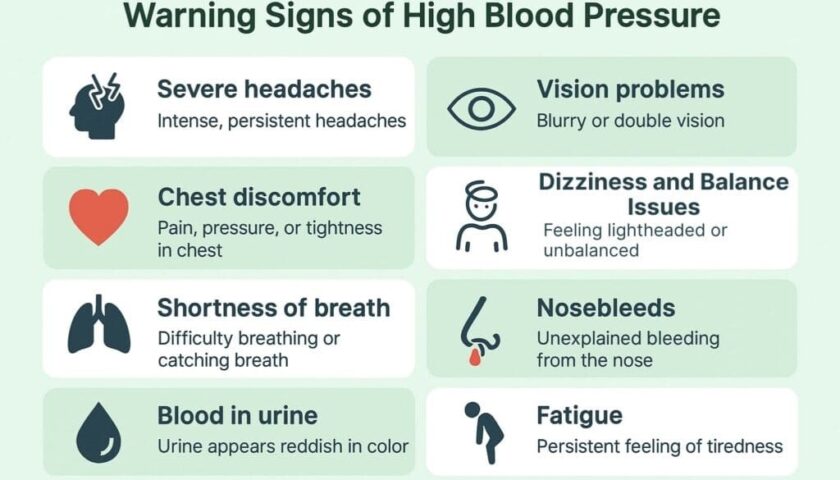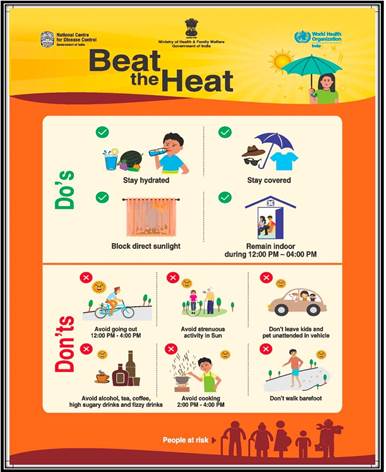Don’t Be a Silent Victim: Unmask the Signs of High Cholesterol
By: Saika J
High cholesterol. It lurks in the shadows of our bodies, often undetected for years. Earning the moniker “silent killer,” high cholesterol rarely throws up flashy warning signs until a critical moment – a heart attack, a stroke, a life forever altered. This lack of symptoms can lull us into a false sense of security, allowing cholesterol levels to climb steadily, silently building a wall of plaque within our arteries.
But our bodies aren’t entirely silent partners in this drama. While high cholesterol itself may not announce its presence with trumpets and flashing lights, there are subtle whispers, gentle nudges that can guide us towards seeking professional help. Let’s embark on a journey of discovery, unveiling 10 warning signs of high cholesterol you shouldn’t ignore.
1. The Family Whisper: Our genes hold a treasure trove of information, not just about eye color or hair texture, but also about our susceptibility to certain health conditions. If your close family members, particularly parents or siblings, have a history of high cholesterol or heart disease, consider yourself on heightened alert. This shared genetic code significantly increases your risk, making it even more crucial to prioritize regular checkups and cholesterol screenings.
2. Echoes from the Heart: The human heart, a tireless pump keeping the lifeblood flowing, can sometimes send out distress signals when things aren’t quite right. Chest pain, pressure, or tightness, especially during physical exertion, can be a worrying sign. This discomfort arises because narrowed arteries, clogged by cholesterol deposits, struggle to deliver sufficient blood – and the oxygen it carries – to the heart muscle. Don’t dismiss these chest sensations as mere exertion aches. Take them seriously and seek medical evaluation to rule out any underlying conditions.
3. Leg Cramps: A Cry for Help from Below: Leg pain isn’t just an annoyance from a long day on your feet. It can be a cryptic message from your body about a potential problem brewing within your vascular system. Leg cramps or pain in the buttocks, thighs, or calves, particularly while walking or climbing stairs, could be indicative of peripheral artery disease (PAD). This condition, often linked to high cholesterol, develops when fatty buildups restrict blood flow to the arteries in the legs, leading to pain and cramping in the affected limbs.
4. The Silent Struggle for Breath: Shortness of breath, especially when you haven’t exerted yourself, can be a cause for concern. While it can arise from various factors, it can also be a subtle warning sign of high cholesterol. When cholesterol builds up in the arteries, it narrows the passage for blood flow. This can lead to a situation where the heart struggles to pump enough oxygenated blood throughout the body, leaving you feeling breathless even at rest.
5. Numbness and Tingling: A Message Lost in Transit: Imagine the frustration of trying to send a text message, but the signal keeps dropping. That’s what can happen with high cholesterol and your body’s communication system. Cholesterol deposits can obstruct blood flow to the legs and feet, causing a disruption in nerve signals. This can manifest as numbness or tingling sensations in the extremities, a sign that something is amiss in your vascular system.
6. Blurry Visions: A Window into Your Health: Our eyes are not just windows to the soul; they can also offer a glimpse into our overall health. Blurred vision, especially in one eye, or experiencing temporary episodes of vision loss (amaurosis fugax) can be connected to high cholesterol. These vision problems can arise when cholesterol deposits affect blood flow to the delicate blood vessels supplying the eyes. If you experience any sudden changes in your vision, consult an ophthalmologist to rule out any underlying causes.
7. Fatty Deposits Around the Eyes: A Physical Warning Sign: Sometimes, the messages our bodies send aren’t whispers or aches; they’re visual cues. The appearance of raised, yellowish bumps near the eyelids or on the corners of the eyes, known as xanthelasma, can be a physical manifestation of high cholesterol. These fatty deposits develop due to cholesterol buildup under the skin. While not harmful in themselves, their presence serves as a red flag, urging you to address your cholesterol levels.
8. Arcus Senilis: A Ring Around the Iris, Not Just Age: A grayish-white ring appearing around the colored part of the eye (iris) is a common occurrence as we age, often referred to as arcus senilis. However, its presence can also be an earlier warning sign in people with high cholesterol. While not a definitive indicator, the development of arcus senilis at a younger age warrants a conversation with your doctor to assess your cholesterol levels.
9. When Intimacy Becomes a Challenge: Erectile dysfunction (ED) in men can have various causes, but one potential culprit is high cholesterol. Reduced blood flow due to high cholesterol can contribute to difficulty achieving or maintaining an erection. When arteries supplying blood to the penis become narrowed by plaque buildup, it can impede the proper engorgement necessary for an erection. This highlights the importance of addressing high cholesterol not just for overall cardiovascular health but also for maintaining a healthy and fulfilling sex life.
10. The Devastating Consequences of Silence: In the most tragic scenario, the first sign of high cholesterol can be a major cardiovascular event – a stroke or a heart attack. These life-altering events occur when a blood clot forms within a narrowed artery, completely blocking blood flow to a vital organ like the heart or brain. While these events may seem sudden and unexpected, they are often the culmination of years of undetected and untreated high cholesterol.
Taking Charge of Your Heart Health: A Proactive Approach
The good news is that high cholesterol is a treatable condition. By recognizing the warning signs and taking proactive steps, you can significantly reduce your risk of heart disease and stroke. Here’s what you can do:
- Schedule Regular Checkups: Don’t wait for symptoms to appear! Schedule regular checkups with your doctor, including cholesterol screenings. The recommended frequency for cholesterol screenings can vary depending on your age, risk factors, and overall health. Discuss this with your doctor to determine the best approach for you.
- Embrace a Heart-Healthy Diet: Diet plays a pivotal role in managing cholesterol levels. Focus on a diet rich in fruits, vegetables, whole grains, and lean protein sources. Limit saturated and trans fats, found in processed foods and red meat, as they can contribute to cholesterol buildup.
- Move Your Body: Regular physical activity is a cornerstone of heart health. Aim for at least 150 minutes of moderate-intensity exercise or 75 minutes of vigorous-intensity exercise per week. Physical activity helps lower LDL (“bad”) cholesterol and raise HDL (“good”) cholesterol.
- Manage Stress: Chronic stress can wreak havoc on your heart health, including elevating cholesterol levels. Explore stress-management techniques like yoga, meditation, or deep breathing to help you cope with daily pressures.
- Maintain a Healthy Weight: Carrying excess weight can put a strain on your heart and contribute to high cholesterol. If you’re overweight or obese, work with your doctor to develop a safe and sustainable weight loss plan.
- Don’t Smoke: Smoking is a major risk factor for heart disease and can further worsen cholesterol levels. If you smoke, quitting is one of the best things you can do for your overall health.
Remember: Early detection and treatment of high cholesterol are vital for preventing heart disease and stroke. By recognizing the warning signs, adopting a heart-healthy lifestyle, and working with your doctor, you can empower yourself to take control of your health and live a long, vibrant life.






